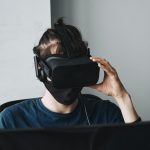Virtual Reality is ruling the training industry these days. Yet there is a bit of hesitation among the L&D and important decision makers of companies to adopt and adapt this training revolution
Misconceptions about VR in general are rampant and mostly based on assumptions. Grounding into scientific facts helps clear most of these myths which can lead to a revolution in training in industries of all kinds. With every new and big technology, being knowledgeable about its inner workings helps make a wise decision and knowing if it’s the right step for your company’s training future.
‘The technology you use impresses no one. The experience you create with it is everything’.
Sean Gerety
With that said here is a list of 7 infamous myths about VR debunked and how they might be stopping your employees from reaching their true training potential.
Myth #1
VR tech cannot be translated into serious training and is only for gaming and funDisruption is the key to growth. With every new technology comes disruption of the one before it. VR has now entered into the training field and is now the need of the time. VR training has challenged traditional forms of learning like classroom and E- learning. VR training’s mark in the education field is making a remarkable position because of its data and measurable outcomes. L&D have the opportunity to track the employee’s responses and accordingly adjust learning outcomes and courses of actions. A major concern of decision makers of institutes is whether VR training distracts one from their training goals when in fact immersion is being misidentified from distraction. Trainees come out of interactive immersive simulations with higher emotional intelligence and enhanced soft skills leading companies to make faster progress. Human resources are one of the most valuable assets to any company in this knowledge driven economy and VR is facilitating that path.
Myth #2
VR training is expensive
This statement was true some years ago when VR was a brand-new technology. Since the infrastructure has grown immensely, this statement does not hold true any longer. According to a study by PWC, VR content is 48% higher in investment but when it comes to a large number of learners, VR training actually turns out to be more cost effective at scale as compared to its classroom or E-learning alternatives. Not to say the return in saved employee time as VR training is 4X faster as compared to classroom learning, reduced from 2 hours to only 29 minutes.
With all evidence pointing towards the fact that VR training is cost effective at scale, it ends up saving money when compared to its E learning counter parts as training modules and lesson contents can be applied to VR training are relevant and applicable in varying types of lessons. The cost of content creation does stand to be a little higher at first, with industry relevant material. With the industry expanding, studios of all sizes are up and coming with making quick content so the L&D departments can rest assured with the fact that economically VR training is a better go to option as compared to laborious E-learning content curation.
Myth #3
VR is not popular among industries for training purposes
According to ‘Virtual Speech’ blog, 21 different industries are already making use of VR technology in some way in their L&D programs. To look at some, the healthcare industry is using VR training to have enhanced and effective workers practice skills through simulations, VR is also making remarkable changes in the mental health industry with helping anxiety and depression patients live with managed symptoms. The military and police force departments are engaging with VR training in order to have the force make better critical decisions and empower existing empathy skills. They are immersed fully with touch, visual and auditory senses which leads to carry the experience with them even when they come out of the simulation to apply it to the real world.
Myth #4
VR training needs large amounts of space to be executed successfully
A common misconception regarding VR use is that it requires the user to have a large amount of space to move in. That could not be farther from the truth. Even though VR training should be executed with a cautionary and safe approach, it need not be practiced in a grandiose space or even require wireless equipment. Training modules are specifically designed to emulate the real-world environment.
With VR headsets getting more accessible and easily affordable, training modules can be easily downloaded and even practiced by employees remotely.
Myth #5
Health of employees is at risk when it comes to using VR technology
Depending on the individual, VR headsets impact everyone differently.
As with most things around us, even VR comes with its own set of rules and precautions. VR training should be conducted in a safe environment free of obstacles which can come in the path of the user while they are in the simulation. The most common feedback given by people sensitive to motion sickness is the feeling of nausea and dizziness when experiencing VR training.
Three suggestions to remove motion sickness that may be caused through VR use are-
- Go through training modules sitting down
- Do trainings for concise periods of time gradually increasing the time spent to avoid cognitive overload
- Setting higher frame rates to different scenarios
VR training is universally accepted among old and young employees, full time and seasonal as well as ones with varying degrees of interest in technology.
There are novel studies being conducted to see the impact of VR simulations on chronic pain relief. Participants suffering from chronic pain can experience simulations with calming and meditative effects using headsets and headphones. For example simulations of going to serene walks on the beach have proven to lead to better pain management and decreased stress.
Myth #6
VR training is just a fancy trend that will pass by soon
One thing is very clear, VR is here to stay. It is clear to investors like Mark Zuckerberg acquiring the VR headset brand Oculus and NASA which is training astronauts for space walks at the moment. VR has unlocked potential in the educational field for mankind in all different ways. One of the biggest things stopping companies from having their workforce reach their best self is the inhibition to adapting to the tech of the present. Granted, everything new is scary and decisions regarding training needs are long lasting. Soft skills training and safety training through VR is giving companies the edge with better equipped staff and highly valuable, non transferable skills. As mentioned above, disruption is a part of evolution but it seems like it will take a while for anything this massive to disrupt the VR industry.
Myth #7
VR training is an isolating experience
Virtual reality’s immersive qualities can be daunting for some and it may seem like getting lost into a world not our own. Yet one of the biggest advantages of VR learning is its capacity to save time while having the capability to hold an employee’s attention for longer compared to any other form of learning. VR training helps remove external distractions which can be seen hindering training like textbook or E-learning. This in turn helps an employee to be more occupied with tasks other than the training. VR training is also seen to be more of a shared experience among employees as this novel experience gets a conversation started and the training is also introduced as a group activity rather than an individual one. Employees who are once fluent in the training can go back to experience it individually to grasp the training better.
Written by Simran Singh







